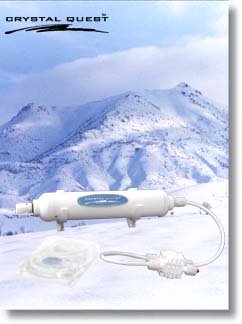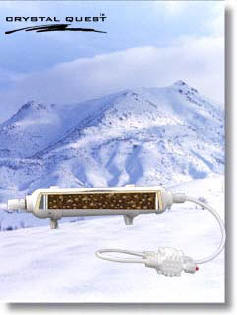CRYSTAL QUEST® Refrigerator Water Filter

CQE-RF-00703
CRYSTAL QUEST® Refrigerator Water Filter and Ice maker water filter is designed for use on refrigerators with ice-makers and/or water through the door. It may be used with water fountains, water coolers, commercial coffee makers and ice machines as well. High-pressure quick-connect fittings can be used on either 1/4" o.d. copper or plastic tubing.
*Water travels through 4 stages of filtration, removing hundreds of contaminants from water.
*Designed in a attractive white housing.
*Conveniently provides an amazing 6,000 gallons
*Easy to install and use, attractive, convenient, and effective.

In stage 1, Water flows through pre and post five - micron filter pads (1 micron equals 1/25,000th of an inch), which remove suspended particles such as silt, sediment, cyst (Giardia, Cryptosporidium), sand, rust, dirt, and other un-dissolved matter.*
In stages 2, Water flows through a bed of media made of a special high-purity alloy blend of two dissimilar metals - copper and zinc (KDF-55D ®, and KDF-85D). KDF is a major advancement in water treatment technology that works on the electro-chemical and spontaneous-oxidation-reduction (REDOX) principles. Chlorine is instantaneously and almost inexhaustibly oxidized in the Refrigerator Water Filter.
Tests on KDF/GAC cartridge have shown 99+% chlorine removal past 20,000 gallons of water. In comparison, carbon cartridges of comparable volumes drop below 90% effectiveness after only 4,000 gallons.
What is KDF?
Kinetic Degradation Fluxion (KDF) is a high-purity copper-zinc formulation that uses a basic process known as redox (oxidation/reduction) to remove chlorine, lead, mercury, iron, and hydrogen sulfide from water supplies.
How does KDF Work?
In short, the KDF redox process works by exchanging electrons with contaminants. This "give and take" of electrons converts many contaminants into harmless components. During this reaction, electrons are transferred between molecules, and new elements are created. Some harmful contaminants are changed into harmless components. Others are electrochemically bound to the KDF media.
Iron and hydrogen sulfide are oxidized into insoluble matter and attach to the surface of the media. Heavy metals such as lead, mercury, copper, nickel, chromium, cadmium, aluminum, and other dissolved metals are removed from the water by the electrochemical process in the Refrigerator Water Filter. They are attracted to the surface of the media, much like a magnet. The Refrigerator Water Filter media inhibits bacterial growth throughout the entire unit. In fact, it has been shown to be reduced up to 90%, eliminating the need for silver, which is commonly used in carbon-only filters (silver is considered a pesticide by the EPA and, as such, must be registered with them).
In stage 3, Water flows through granulated activated carbon (GAC). GAC is universally recognized and widely used as an effective adsorbent for a wide variety of organic contaminants, such as chlorine (99.9%), chemicals linked to cancer (THM's, benzine) pesticides, herbicides, insecticides, volatile organic compounds (VOC's), PCB's, MTBE's and hundreds of other chemical contaminants that may be present in water causing bad taste and odor.*
Granular Activated Carbon (GAC) is a highly absorbent material used to remove contamination from water. Activated carbon has been known as a miracle filter media by many researchers because of its unique ability to remove offensive tastes, odors, color, chlorine and volatile organic chemicals, pesticides and trihalomethanes (a group of suspected carcinogens).
Briefly, activated carbon acts like a sponge, with a large surface area to absorb contaminants in the water. The surface area of one pound of activated carbon is equal to 125 acres. Many scientists believe this is a result of an affinity that these chemicals have for carbon because of Van Der Waal forces. Activated carbon is the preferred treatment and method recommended by the EPA to remove a host of potentially hazardous and possibly carcinogenic chemicals in drinking water.
Carbon is extremely porous and provides a large surface area for contaminants to collect. Carbon-only filters must also use their capacity for chlorine removal, resulting in a shortened life. They also may use a bituminous coal carbon, which is good at removing chlorine, but not as effective at removing chemicals. We use a high-grade coconut shell carbon that is most effective at removing chemicals. Coconut shell carbon provides a significantly higher volume of micro-pores than either coal-, wood or lignite-based carbon.
As a result, it is more effective than other carbon types in removing trihalomethanes (THM's) and other chemicals from municipally supplied water. Since our Refrigerator Water Filter REDOX media removes the chlorine before it reaches the carbon, the carbon capacity is not wasted on chlorine and is free to concentrate more effectively on organic contaminants.
In stage 4, Water flows through another five-micron filtration pad for further reduction of undesirable particles. The end result is total elimination or great reduction of a wide variety of contaminants.


